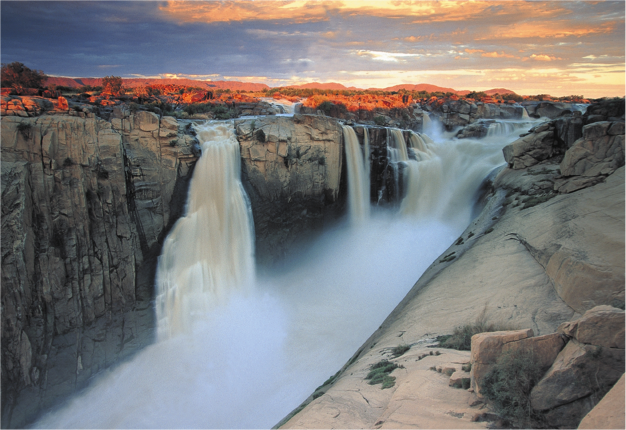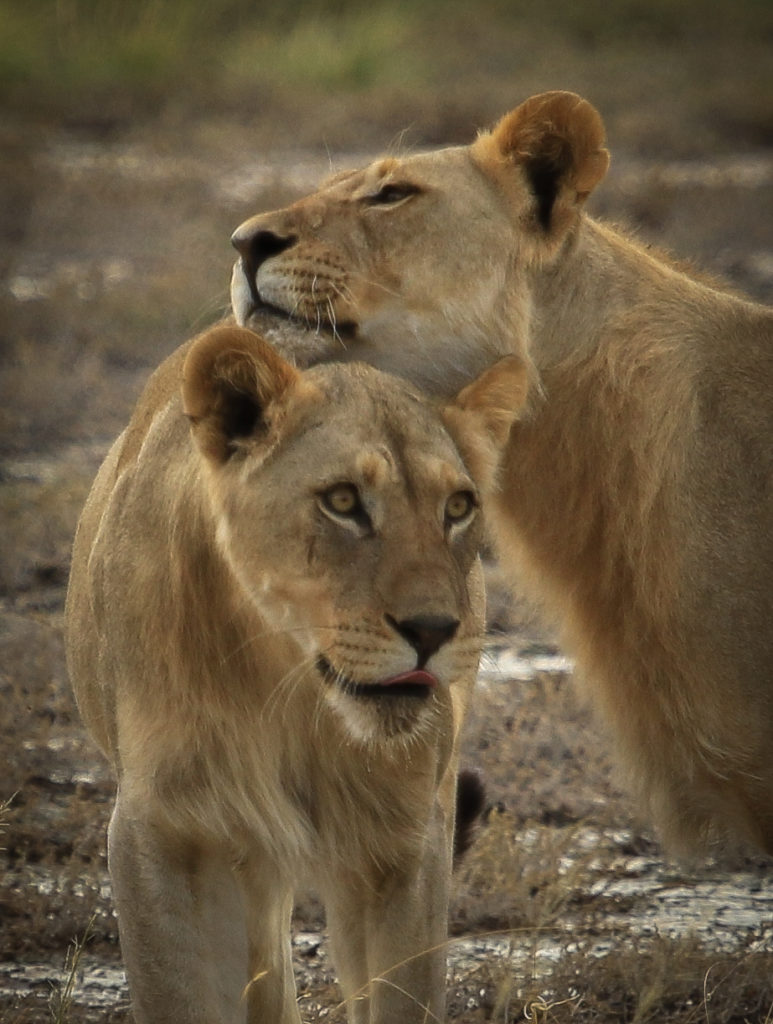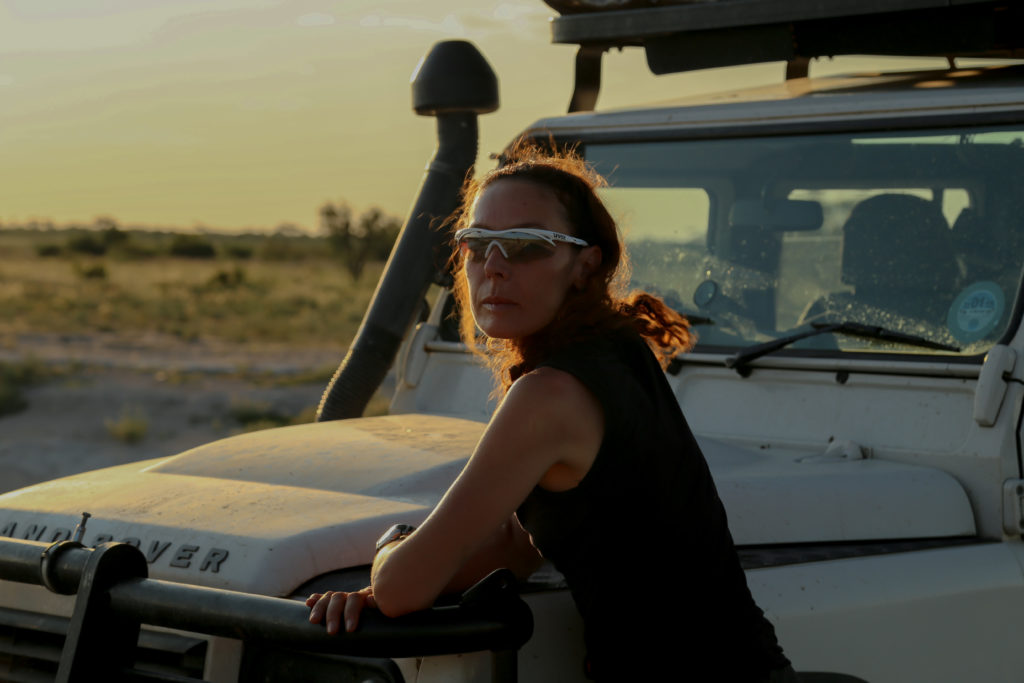Secret South Africa
WATERFALL AND WILDLIFE
- South Africa
- Duration: 13 days
- Self-drive, experience required
Areas of Interest
Located 50 miles south-west of the Northern Cape’s capital; Kimberley, Mokala National Park is home to a number of endangered wildlife species including both species of rhino, roan antelope and tsessebe.
A wild and truly African safari park with red earth, tall grasses and game animals around every twist and turn in the road, visitors to the national park will enjoy numerous up-close sightings of a number of game species including white and black rhino, nyala, giraffe, and bat-eared fox. The park-run guided game drives are definitely worth booking, especially the sunset drive that takes visitors out at night where they will be able to have sightings of some of the nocturnal animals seldom seen on self-drives. A newly established reserve, the self-catering cottages are well-maintained and fully equipped.
Amazing scenery! The Augrabies Falls are a 145 m waterfall and is a magnificent sight to behold.
Aside from the beautiful scenery and breath-taking natural splendor of the Augrabies Falls, the game drive does not provide sighting of the abundant game but is still recommended as a way of getting a bigger overview of the reserve and its landscape. The walkways and viewpoints are occasionally damaged from water and visitors are advised to be cautious and not allow small children to run around too close to the edge.
You will find this park ideal to visit if you are planning to extend your holiday to South Africa with a prime location for wildlife viewing. It is the land of the extremes, with summer temperatures exceeding 105 F (40 C). Animals have adapted to these conditions, and the areas around the Auob River and the Nossob River Valley are very rich in wildlife.
Itinerary
Day 1 – Arrive Johannesburg – Afrique Boutique Hotel
One of our Team members will be waiting for you at the airport for your transfer to Afrique Boutique Hotel. The Afrique Boutique Hotel is a luxury 4-Star Boutique Hotel situated approximately 7kms from OR Tambo International airport. Each of our uniquely decorated double en suite extravagant rooms offers guests a haven where they can feel at home.
Service: Half Board
Day 2 & 3 – Mosu Lodge – Mokala National Park
The isolated dolerite hills give this beautiful National Park a calming feeling of seclusion. When you pass through the hills and are confronted by the large open sandy plains towards the north and west of the Park. From these hills form little tributaries that run into the plains and drain into the Riet River. Mosu Lodge, our accommodation during our stay at Mokala, boasts a cool sparkling swimming pool for the warmer months, restaurant with bar facilities, outside lapa, lounge, and entertainment area with built-in fireplace. Game drive activities complete an unforgettable experience.
Service:
Driving time: 6h
Day 4 & 5 – Augrabies National Park
Picturesque names such as Moon Rock, Ararat and Echo Corner are descriptive of this rocky region, characterized by the 13-miles abyss of the Orange River Gorge and craggy outcrops dominating scrub-dotted plains. Klipspringer and kokerboom (quiver trees) stand in stark silhouette against the African sky, silent sentinels in a strangely unique environment where only those that are able to adapt ultimately survive. The 28,000 hectares on both the northern and southern sides of the Orange River provide sanctuary to a diversity of species, from the very smallest succulents, birds and reptiles to springbok, gemsbok and the endangered black rhino.
Service: Rooftop tent and self-catering or Chalet
Driving time: 6h
Day 6 & 7 – !Xaus Lodge – Kgalagadi Transfrontier Park
Pronounced ‘kaus’, the lodge is a place to experience a unique desert environment, providing accommodation in the heart of the Kgalagadi Transfrontier Park for eco-tourists and visitors to the Kalahari. The beautiful Kgalagadi Transfrontier Park is a conservation area measuring over 3.5 million hectares, almost twice the size of the Kruger National Park. The Kgalagadi offers stunning scenery, excellent birding and an overpowering silence under the clear night sky. Some of the highlights of the lodge include a cozy lounge with a fireplace, a large observation deck perfect for stargazing, a refreshing swimming pool and a heartwarming fire in the boma, perfect for enjoying the beauty of the night sky.
Service: Rooftop tent and self-catering or Chalet
Driving time: 6h
Day 8 & 9 – Nossob Rest Camp/Campsite – Kgalagadi
Nossob Rest Camp is situated within the dry riverbed of the Nossob. The camp is surrounded by savannahs and is famous for spectacular predator sightings. The camp has a reception area, swimming pool, predator information center, shop, and fuel facilities, and a generator provides electricity for 18 hours per day. There is no cellphone reception available at the camp which adds to the tranquility and peaceful atmosphere at Nossob. Depending on your wishes, we may organize your stay at the camp, or in the campsite in the area.
Service: Rooftop tent and self-catering or Chalet
Driving time: 4h
Day 10 & 11 – Twee Rivieren Rest Camp/Campsite – Kgalagadi
Twee Rivieren Restcamp is a welcome place to come home to after a day of rewarding game-viewing. Twee Rivieren is the largest rest camp in the huge Kgalagadi Transfrontier Park. Occupying an impressive position on the dry Nossob river bed, the camp is particularly well noted for its seasonal migrations of desert herbivores, such as blue wildebeest and red hartebeest, as well as the ever-trailing predators, yielding exciting hunts and game viewing from the camp.
Service: Rooftop tent and self-catering or Chalet
Driving time: 4h
Day 12 – Game View Lodge – Vryburg
Today, on your way to Johannesburg you will stop at Game View Lodge, an up-market lodge situated in the town of Vryburg next to the Leon Taljaard Game Reserve. Whilst enjoying a sundowner on our deck you will be able to view game which includes 2 of the Big 5 and the most beautiful sunsets. Vryburg, also known as the Texas of South Africa, is situated in the North West Province, thus being the ideal place to stay over.
Service: Full Board
Driving time: 6h
Day 13 – Johannesburg – Airport
The last day of the itinerary is a long and pleasant drive to the airport, right on time for your return flight.
Driving time: 4h 30′
Extensions
The game reserve is located north of Durban in the world-famous KwaZulu-Natal, right in the heart of Zululand. The ideal destination for the self-drive safari, with plenty of choices of accommodations. This is the oldest reserve in South Africa. It is a Big Five reserve, and at the same time, large packs of wild dogs are often seen. The Park covers more than 96,000 hectares and contains an immense diversity of fauna and flora. Hluhluwe Umfolozi Reserve is characterized by hilly topography and the northern section of the game reserve is noted for its wide variety of both birdlife and wildlife. iMfolozi Game Reserve is situated in the southern section of the Hluhluwe Imfolozi Park. The Hluhluwe Imfolozi Park is world renowned for its White Rhino conservation and the Centenary Capture Centre is setting exceptional standards for animal capture and sustainable utilization in Africa.
A truly original extension to a classic safari in South Africa, and a Unesco World Heritage site. The iSimangaliso Wetland Park is one of the outstanding natural wetland and coastal sites of Africa, covering an area of 239,566 hectares. The wetland park is a huge protected area along the coast of South Africa’s KwaZulu-Natal Province.
The park’s centerpiece is the vast Lake St. Lucia, home to large numbers of hippos, crocodiles, pelicans, and flamingos. Elephants, giraffes, and leopards inhabit the grasslands and forests of the nearby Western Shores and Charters Creek areas. To the north, Sodwana Bay is known for its colorful coral reefs., it includes a wide range of pristine marine, coastal, wetland, estuarine, and terrestrial environments which are scenically beautiful and basically unmodified by people. These include coral reefs, long sandy beaches, coastal dunes, lake systems, swamps, and extensive reed and papyrus wetlands, providing critical habitat for a wide range of species from Africa’s seas, wetlands, and savannas.
Cape Vidal offers the best of two worlds – it is situated on the exquisite Zululand coast with all its amazingly rich marine life, and it provides direct access to the Eastern Shores Nature Reserve with its populations of elephant, rhino, buffalo, crocodile, hippo and reedbuck to name but a few.
The beach and off-shore areas at Cape Vidal fall within the St Lucia Marine Reserve which is visited seasonally by humpback whales during their migrations, as well as loggerhead and leatherback sea-turtles that come to the beaches north of Cape Vidal from November to February to nest. Other marine “big game” includes the huge whale shark, marlin, sailfish and dolphin.
A large park, it is the fourth largest in South Africa, with its 55 000 hectares, and it is completely malaria-free.
Pilanesberg lies between the transition zone of the dry Kalahari and wetter Lowveld vegetation, commonly referred to as “Bushveld”. Unlike any other large park, unique overlaps of mammals, birdlife and vegetation occur because of this transition zone.
Springbok, brown hyaena, the red eyed bulbul, and camel thorn trees usually found in arid areas are found cohabitating with moist-area-limited impala, black eyed bulbul and Cape chestnut trees.
The Pilanesberg is famous for the geology, and many professionals are traveling in the area to study the Pilanesberg National Park Alkaline Ring Complex, an area formed by volcanic eruptions some 1200 million years ago, and a unique and wide range of habitats for game animals. Wildlife is abundant, and the carrying capacity of the park is outstanding. As well as the ‘Big Five’ you will find the nocturnal brown hyena, cheetah, hippo, crocodile and even sable in the Pilanesberg National Park.
We are still in KwaZulu Natal Province, the Drakensberg creates a natural border between Lesotho and KwaZulu Natal. In the local language, they are simply known as ‘the dragon mountain’ or Drakensberg. It is the highest mountain range in the country, reaching an impressive 3 482 meters above sea level.
Within the Drakensberg of KwaZulu Natal lies the 243 000 hectares mountain region that is also a Unesco World Heritage site. The area is perfect for an active holiday: hiking is fantastic, as well as horse trails, white water rafting, abseiling, and more.
For the offroad enthusiasts, the place to be is the Sani Pass, undoubtedly one of the most spectacular and scenic mountains passes in the whole of Africa. The Sani Pass lies between South Africa and its small landlocked neighbor, Lesotho. As the only road that crosses the summit of the Drakensberg mountain, the pass attracts adventurous travelers from across the world who wish to traverse the breathtaking natural scenery this precarious mountain has to offer — a must-do for any adventurous bucket list!
A blend of cultures, cuisines, and landscapes, there’s nowhere quite like Cape Town, a singularly beautiful city crowned by the magnificent Table Mountain National Park.
We suggest to spend at least three to four days in the area and go beyond visiting only this beautiful city. The first day is normally used to walk around the street, while in the afternoon, you will make your way to the summit of Table Mountain with a cable car. From Table Mountain, one of the 7 wonders of nature, spectacular views of the city, the Peninsula and Robben Island will leave you in awe. Nightlife in Cape Town is fantastic. You will have the opportunity to enjoy dinner at one of the various excellent restaurants in town.
The second day we suggest to Cape Peninsula experience the scenic beauty and natural landscapes of South Africa’s Cape Peninsula on this full-day tour from Cape Town. The drive is amazing and places like Hout Bay and the Seal Island Boat Cruise are unique experiences you cannot miss. Chapman’s Peak Drive is the most scenic drive in the world, with cliffs on one side and ocean on the other, with photographic stops made along the way. Today you will also visit the famous Cape of Good Hope Nature Reserve and Cape Point and Boulders Penguin Colony, one of the most famous penguin colonies.
A visit to Cape Town can only complete with a visit to Cape Winelands. This is a 40 minutes drive from the city. The beautifully located towns of Stellenbosch and Franschhoek are within easy reach of Cape Town and are some of the oldest towns in the country with a rich history and culture. If you want, we can organize for you a guided tour of these two towns and also visit 3 top wine estates for wine tasting before we make our way back to Cape Town.











